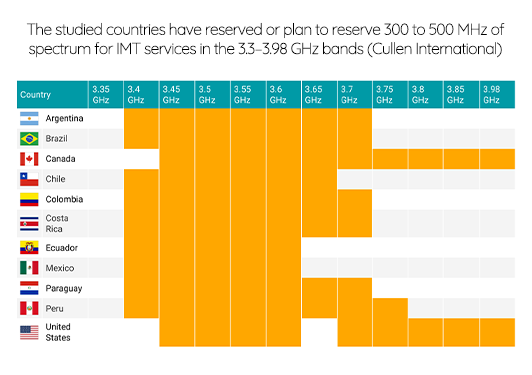Almost all countries in the Americas have adopted a plan to use the 3.5 GHz band for 5G, but there are significant differences in the timing for awarding licences and in the amount of spectrum that will be used.

Many countries have already auctioned spectrum to award the band, while others, such as Paraguay, started refarming of the band in order to make more efficient use of the spectrum. Chile reorganised the 3300–3650 MHz band to enable the current licensees to have contiguous spectrum and awarded 50 MHz to Claro in June (3550–3600 MHz).
In August 2024, the Peruvian government established a special mechanism for the direct assignment of additional spectrum for 5G at the request of interested parties. MTC is planning a direct assignment of 500 MHz of spectrum in the 3.3–3.8 GHz band.
The World Radiocommunication Conference 2023 (WRC-23) identified the 3300–3800 MHz band for international mobile telecommunications (IMT, Flash) in the Americas, expanding on its previous identification:
- 3300–3400 MHz: all Americas;
- 3600–3700 MHz: all Americas; and
3700–3800 MHz: Bahamas, Belize, Brazil, Canada, Colombia, Costa Rica, Guatemala, Paraguay, Peru, Trinidad and Tobago, Uruguay and USA.
To access the full benchmark, please click on “Access the full content” - or on “Request Access”, in case you are not subscribed to our Americas Spectrum service.
more news
29 July 25
New benchmark on provisioning timers and SLAs for wholesale local access over fibre in Europe
Our new benchmark covers service level agreements (SLAs) for the provisioning of wholesale local access (WLA) over fibre unbundling and virtual unbundling (VULA) across 18 European countries.
28 July 25
Privacy in the digital age
This Global Trends benchmark compares key aspects of data protection laws across 14 jurisdictions: Australia, Brazil, Canada, China, the EU, India, Indonesia, Japan, Kenya, Korea, Singapore, South Africa, the UK and the US.
25 July 25
Few EU countries have yet designated authorities to enforce new EU rules on data and AI
Our new benchmark maps the authorities designated to enforce the Data Governance Act, the Data Act and the Artificial Intelligence Act across all the 27 EU member states.